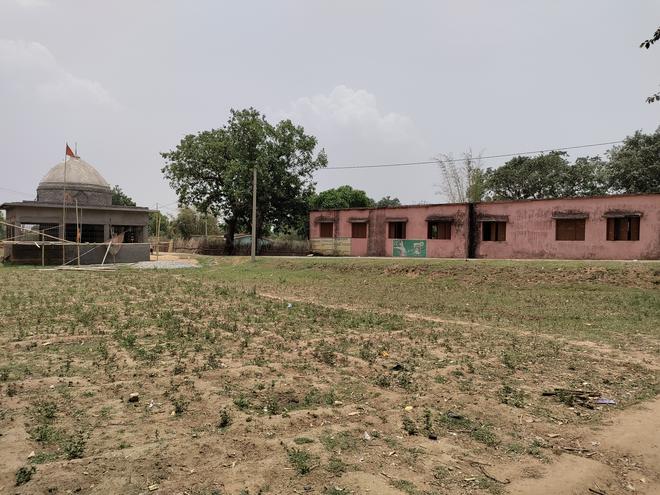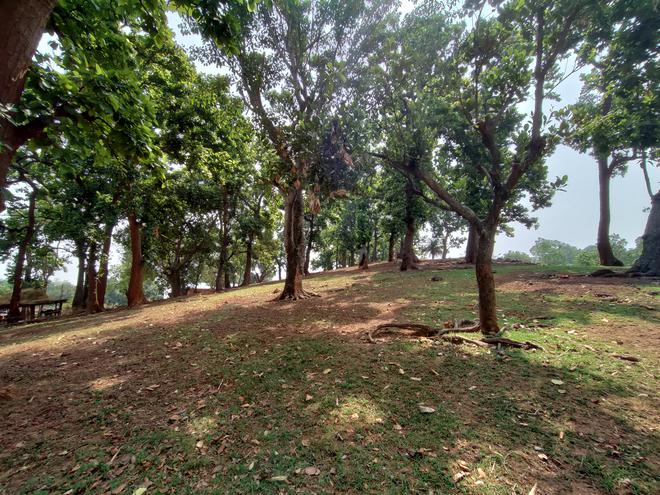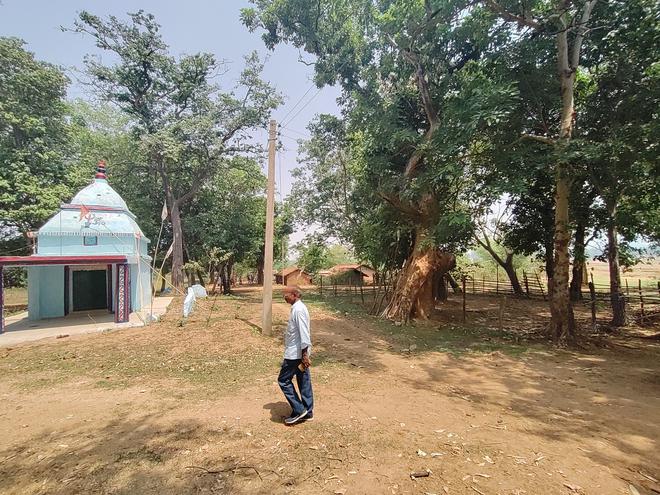From the capital, Ranchi, to the highways branching out into the forested villages where most of Jharkhand’s tribal population lives, flags asserting a religious identity can be found fluttering nearly everywhere. Along highways, wherever there is a red-and-white striped flag, the marker of the Sarna tribal religion, there is also a saffron one with Hindu gods planted next to it — each vying to establish its dominance over the other.
As the demand for a separate Sarna religious code in Census 2021 gathers steam in the State, there is tension in tribal-dominated villages. On the one hand, Hindu groups backed by the Rashtriya Swayamsevak Sangh (RSS) are leading efforts to “develop” tribal villages by making them aware of “their cultural and traditional roots”. On the other, tribal activists led by outfits such as the Kendriya Sarna Samiti (KSS) are resisting these efforts saying the Hindu groups have taken a page out of the playbook of Christian missionaries to subsume their distinctive culture and identity under the umbrella of Hinduism by “brainwashing” the poorest tribal people.
“Christian missionaries first started converting poor tribal communities with the promise of an English education, jobs and hospitals. Now, Hindu groups are using the same methods to do something more malicious: changing the very nature of what tribal people believe Sarnaism to be and how it should be practised,” said Handu Bhagat, a KSS activist in Gumla district, which has the highest proportion of the Scheduled Tribe (ST) population in the State.
He explained that groups like the Vanvasi Kalyan Kendra (VKK), which is backed by the RSS, start by visiting people in the remotest tribal villages every day and building connections with them. The “indoctrination” begins with the promise of elementary schools, pucca homes for villagers, and roads and electricity for the village, he said.
“The more time they spend with the villagers, the more they try to convince them that the basic principles of Sarnaism and Hinduism are the same even though our practices are distinctively different from any other religion,” said Bandhan Tigga, who is known as a Sarna “Dharmguru” among the tribal people, at his ashram in Murma.
Tigga, who was among the pioneers of the movement for the Constitutional recognition of the Sarna religion in Jharkhand, explained that while Hindus worship different gods believing them to be a manifestation of nature, tribal people worship nature or what they call ‘Maa Sarna’.
“We do not have any concept of idol worship; our practices follow natural laws and are not codified ones that you see in other religions. Most importantly, we have always resisted the onslaught of any other religion. So, how is it that someone can come and claim Sarnaism as a part of Hinduism,” Tigga asked.
And once this “ideological encroachment” takes hold, he said, the physical encroachment begins, starting with establishing Hindu temples at Sarna places of worship and culminating in the erasure of traditional tribal rituals and practices.
A village in transition
In Sugakatta village of Gumla district, these efforts of the VKK are near-complete. Located just below the forested hills near the Sikoi Panchayat area, Sugakatta is dominated by the Nagesia tribe, also known as Kisan, a notified ST. For as long as 60-year-old Birju Nagesia, the village pramukh, can remember, the people have worshipped at the Sarna sthal (a patch of land with a sacred grove of Sal trees) uphill in Sikoi, where locals from nearby villages also gathered. But now, after over a decade of the VKK’s active presence in their village, when asked which religion he would identify as, Birju Nagesia, like most other villagers, stole a glance at the local VKK functionary before saying, “Hindu, of course.”
“What is Sarna and what is Hinduism? We believe we are descendants of Lord Shiva and we worship nature, as do Hindus. So, I don’t see Hinduism as a different religion. Traditions and practices in Hinduism vary from region to region and I see our rituals as a part of the Hindu religion,” Birju Nagesia said. The villagers have now started worshipping Lord Shiva and Goddess Parvati in their ‘Devi Mandir’ and are also preparing for the opening of a Hanuman temple, under construction in the centre of the village, courtesy of funds collected by the VKK, he said.

But this is not the only change the VKK’s presence in Sugakatta has triggered in the last decade. The village now has a pitch road connecting it to the highway towards the Gumla district centre, built under the Pradhan Mantri Gram Sadak Yojana; almost all families have pucca homes, built under the Pradhan Mantri Awas Yojana; and the entire village now has access to power.
“We put our might behind the project. We connected with as many people in the ruling BJP (Bharatiya Janata Party) we knew and used all the resources at our disposal to bring these government schemes here,” said Naresh, the local VKK functionary. The purpose of his organisation’s work in Sugakatta was to turn it into a model village, he said.
Raghav Rana, the VKK’s Regional Gram Vikas chief for Jharkhand and Bihar, said, “We first created a pool of 10-12 tribal villages after field visits. After careful consideration, Sugakatta was selected to be developed as an example of what we can do.”
Naresh added that they are also helping the locals, a primarily farming tribe, make their own organic compost by setting up pits in the village and helping them package and sell their produce at prices they could not dream of earlier. In addition, the VKK runs an ‘Ekal Vidyalaya’ in the village for children aged four to 10 years, where they are taught to respect elders by touching their feet, sing devotional songs about Hindu gods and goddesses, and prepared for enrollment into government schools, he said. “We believe in imparting ‘Sanskritik Prathmik Shiksha’,” Rana said of the programme. The VKK runs 389 elementary schools across Jharkhand’s tribal villages, he added.
Further, the organisation runs 419 ‘Shraddha Jagran Kendra’. Rana said these “help tribal people celebrate their traditions grandly” through events like ‘Shobha Yatras’, “beautification” of their places of worship, and pujas every week to bring the community together.
These activities are what Tigga and the KSS describe as the Hindus’ onslaught on Sarnaism. “We do not have any practice of worshipping every week or every day. We observe festivals like Sarhul, Karma puja (worshipping a branch of the Karma tree) once a year. Our daily worship is to express gratitude to Maa Sarna before meals,” said Satyanarayan Lakda, the KSS Jharkhand chief in Ranchi.
The concept of “beautifying” Sarna places of worship by building temple-like structures goes against the basic tenets of Sarnaism, Tigga said. “We worship the land of the Sarna sthal where our sacred trees grow. These attempts to “ beautify” places are corrupting the nature of how we worship and what we consider sacred.”
Aware of the pushback from outfits like the KSS and the Rashtriya Adivasi Samaj Sarna Dharm Raksha Abhiyaan, Rana defended their work in Sugakatta: “How can anyone equate our work with that of Christian missionaries? We do not convert the tribal people. We do our development work with a focus on preserving their traditions. All we are saying is that there is practically no difference between Sarna practices and Sanatan Hindu practices. We are just helping them celebrate their traditions as grandly as possible.”
The VKK’s parent organisation, the Akhil Bharatiya Vanvasi Kalyan Ashram, was started by Ramakant Keshav Deshpande in 1952 as a resistance to the Christian missionaries who were influencing conversions at the time, according to the organisation’s website. It describes tribal people as ‘ vanvasi’ (forest dwellers), saying there were references of such characters in Hindu epics such as the Ramayana and Mahabharata thus concluding through its slogan, “ Tu, Mai — Ek Rakt (You, me — same blood).”
Pointing to the VKK’s Ranchi zone chief, Sukhi Oraon, Rana asserted that tribal people are with them in their efforts. A member of the Oraon tribe, Sukhi Oraon opposed the efforts to establish Sarnaism as a separate religion, referring to people leading the movement as those “trying to gain political mileage by dividing the country”. He added, “We work to unite the nation, not divide it.”
Sarna sthals under attack
About 50-60 km north of Sugakatta is Maheshpur village in the Chainpur block of Gumla district. It is mostly inhabited by the Kharia people, a hunter-gatherer tribe who had been praying at a two-acre patch of land where their Sarna sthal was till about five years ago. Now, the Sarna sthal has been reduced to a 200 sq ft plot of land. It is guarded by bamboo barricades with the sacred grove in the centre, beside which a Sarna flag has been firmly planted. The majority of the plot has been taken over by a Hindu temple.
The VKK’s presence in the Gumla district and its work in Sugakatta has caused ripples across the area, said Bhagat of the KSS. Temples were coming up at Sarna places of worship, he said. Pointing at the Maheshpur Sarna sthal, Bhagat said, “Look, most of the land has been taken up by the temple and the villagers have been forced to settle for the smaller patch.”
Dheeraj Kharia, 50, who lives next to the Sarna sthal, said the dispute over the land had been going on for over a decade, but after a few skirmishes in the last five years, which required the police to be called in, the area for Sarna worship was reduced and barricaded. “A couple of years ago, KSS activists planted the flag and strengthened the barricades. But we have copies of the registry papers showing that the entire plot was for Sarna worship,” he said.
Such alleged “encroachments” upon Sarna sthals are not just by Hindu groups. In the Tin Tangar village, a few kilometres from Maheshpur, locals worshipped Maa Sarna on two-and-a-half acres of land on a hillock. But a church that had come up beside it has now built a grotto atop the hillock after cutting down a few trees. After a few skirmishes with church authorities, the police stepped in and the Sarna believers were forced to go downhill. There, they planted one fresh Sal tree to worship. Balram Rautia, the pahan (a Sarna priest) of Tin Tangar, said the area is still tense and locals are allowed to worship the sacred grove only under the strict supervision of law-enforcement authorities once a year for Sarhul.

Significantly, Bhagat said they are not getting much support from the State government to protect Sarna sthals. The Jharkhand government has in place a Gherabandi scheme, which promises State funds to the welfare department to create concrete boundary walls around sacred Sarna religious spaces, including both places of worship (Sarna sthals) and places of mourning (Masna sthals), to protect them from encroachment. According to data from the district office, in Gumla, the government had allocated ₹22.01 crore for the protection of 191 Sarna and Masna sthals between FY 2017-18 and FY 2021-22. Of these, work remains incomplete at 103 locations. Many of these are like the ones in Maheshpur and Tin Tangar: in dispute due to the existence of structures of other religions, according to district officials.
Those leading the movement for a separate Sarna code have maintained that their tribal identity is being threatened by all religions looking to either convert them or subsume them under their own religious identity. “Historically, we have always resisted attempts to erase our cultural and religious identity and that is shown in our practices. For instance, when Hinduism came up, Adivasis started animal sacrifice, specifically the sacrifice of an adolescent cow, to keep Hindus at bay. Then, when Islam came, many tribes started sacrificing pigs and we started using pig fat and hair in our rituals to keep them at bay. So, the fact that we want to set ourselves apart is not new,” Tigga said.
With the Supreme Court finally ruling this year that there needs to be a “foolproof” mechanism to determine what constitutes tribal identity and who can be called a tribal, the Sarna code movement in Jharkhand is now moving towards positioning itself as an answer to the question: Who is an Adivasi? The criteria prescribed by the Union Government to identify a person as a member of aN ST are: indications of primitive traits, distinctive culture, geographical isolation, shyness of contact with the community at large, and backwardness. But as High Courts and the Supreme Court have observed in the last few years, these may not be the most appropriate or sufficient conditions to identify a person of tribal origin.

Jaleshwar Bhagat, a tribal activist, associated with Tigga’s Chhatriya Sarna Samiti, explained, “It is no longer necessary for tribal people to have primitive traits, or be geographically isolated or shy of contact with the community at large. These aspects are changing rapidly and the only thing we can tether our identity to seems to be our distinctive practices of Sarnaism.”
Finding identity
Tigga said practising Sarnaism ties tribal people to their roots as people who lived among nature and one with it. They take from nature and preserve it through their traditions. And this is why, Tigga added, their movement must move towards defining Adivasis by whether they practise Sarnaism or not, in a bid to protect their culture. Karma Oraon, an anthropologist and a senior member of the Rashtriya Adivasi Samaj Sarna Dharm Raksha Abhiyaan (RASSDRA), explained that this idea of identifying tribal people by their religious practice can be traced back to what Lohardaga MP, Kartik Oraon, had brought up in Parliament in the late 1960s. He had argued that this aspect of tribal life was what distinguished them from all other communities and hence this should be the deciding criterion.
Quoting 2011 Census figures, Karma Oraon said that more than half the people who had marked their religion under the “Others” column identified as Sarna or Sarnarthi, which amounted to a little over 49 lakh people, of which around 42 lakh live in Jharkhand. “This is more than the recorded believers of other religions like Jainism,” he said. “Why then can’t Sarna be recognised as a separate religion?”
But this push to define tribal identity by a people’s association with the Sarna religion is also exclusionary to a certain extent. KSS Ranchi chief Lakda said, “Since Sarna is what sets us apart as tribal people, the government benefits available for tribal populations should also be restricted to only those who believe and practise Sarnaism. That is how we will know who is Adivasi.”
There are 32 notified STs in Jharkhand but only five of the most populous tribes (Santhal, Oraon, Munda, Ho and Kharia) officially identify as Sarna believers. The others mark their religion as ‘Adivasi’, enter their tribe name, or other names for their traditional practices such as ‘Addi Bassi’, ‘Sarvdharm’ and ‘Adi’. Apart from them, there are large groups of the tribal population that have converted to Christianity or other religions generations ago.
Lakda said, “The first to be excluded from government benefits for tribal people should be those who have converted to another religion, because they chose to abandon their tribal identity. If someone is not adhering to Sarna practices, how can we call them Adivasi?”
But given the diversity of traditional practices of nature worship among tribes, Tigga said their efforts are now also being directed towards uniting them under the umbrella of Sarnaism. “So, now our work is largely about visiting tribal villages, spreading awareness about their traditional religious practices and why they must resist attempts to be mis-categorised. No matter the tribe, these traditional practices based on nature worship are essentially Sarnaism and we are taking this message to as many people as possible,” Tigga said. He added that they are also now marking their presence by planting their red-and-white striped flags at Sarna sthals across villages.
He explained that unlike Hinduism, Christianity, Sikhism and other religions, Sarna believers had no way of taking markers of the religious belief with them as they migrated out of their villages in search of jobs. “Traditionally, there was just one Sarna sthal for a group of villages and everyone worshipped there. When tribal people started moving to the cities, they could not possibly take the ground they worshipped with them and so the practices died among urban tribal people,” Tigga said. “We are also encouraging those in the cities to assert their Sarna identity through symbols like the Sarna flag.”
The Hemant Soren-led Jharkhand Mukti Morcha government has already supported the demand for a Sarna code by passing a resolution in the Assembly. This has allowed Soren to get the sympathy of the tribal people by claiming that now it was up to the Union Government to get on board, as he did while in Gumla on June 8, ahead of the Mandar Assembly bypoll.
As the KSS, the RASSDRA and other tribal groups nationwide decide the future of protests demanding the Sarna code, efforts are on to tie tribal identity exclusively to the Sarna religion. But the fate of this will largely depend on the decision of the Supreme Court bench that will now be tasked with setting down the definitive criteria based on which a person’s tribal identity can be established.







